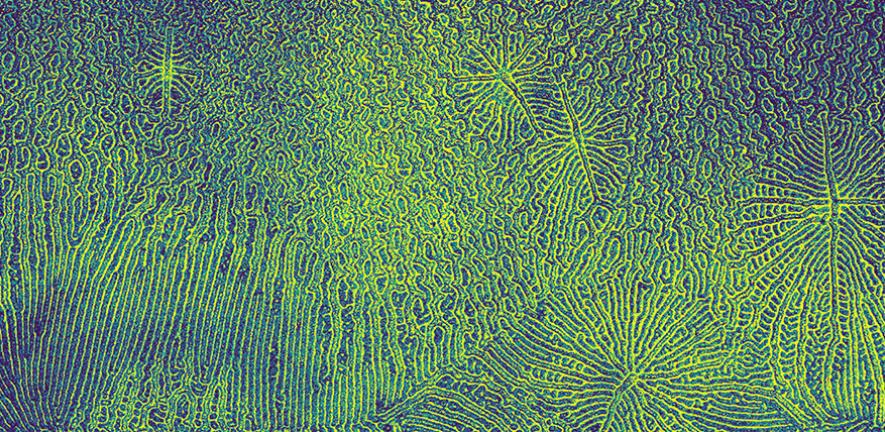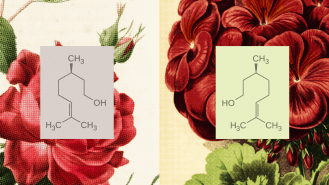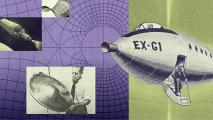You may not realize it, but your hands are key to one of science’s most enduring philosophical conundrums.
Your right hand is essentially a mirror image of your left, but the two are not superimposable, meaning they don’t line up perfectly if you lay one on top of the other. Objects with this kind of asymmetry are described as “chiral,” which comes from the Greek word “cheir,” meaning “hand.”
Other examples of chiral objects in everyday life include snail shells, which swirl clockwise or counterclockwise, and scissors, which come in left- and right-handed versions. Chirality also appears in chemistry, with certain molecules having so-called left- and right-handed configurations that are non-superimposable mirror images of one another.
All of biological life is homochiral — it’s either right- or left-handed, never both.
If you’re left-handed and you try to use a pair of right-handed scissors, you’ll notice the annoying difference but will likely still be able to cut paper. Differently handed versions of the same molecules, however, can produce startlingly different results despite having the same atoms and bonds.
The molecule citronellol, for example, will smell either like rose or geranium, depending on its handedness. L-methamphetamine (the “L” stands for “levo,” or “to the left”) is used as a nasal decongestant and can be found in over-the-counter Vicks inhalers. D-methamphetamine, meanwhile, where the “D” stands for “dextro” to indicate right-handedness, is a recreational intoxicant that is definitely not available at CVS.
Chirality was initially discovered and manipulated in biochemistry, but it is now becoming a major force in tech R&D, with applications ranging from fast-charging EV batteries to longer-lasting, practically bottomless hard disks. As research and technology progress in tandem, we inch ever closer to discovering what, if anything, chirality tells us about nature and the universe — as well as closer to the controversial possibility of creating “mirror life.”
From tartrates to tragedy
Almost everything we know about the physical world, at least at the atomic level, comes from observing how matter interacts with light. The atoms in each element absorb and emit light in a unique way. More subtly, chiral structures make a change to the orientation of circularly polarized light as it passes through them.
In 1848, 26-year-old Louis Pasteur was studying tartrates, the crystalline deposits that form in a bottle of natural wine (he was French, after all). He was trying to figure out why the natural version of the substance rotated the plane of polarized light while a seemingly identical synthetic analog of tartrates did not.
Squinting through a magnifying glass, Pasteur observed tiny faces in the crystals that were structural opposites of one another. Driven by curiosity and superhuman patience, he separated the left- and right-facing crystals using tweezers, then dissolved them in solution to test for optical activity.
What he found was that single-handed solutions, which contained only left-facing crystals or only right-facing ones, twisted the light shining through them. However, mixed-handed solutions, which contained both versions of the crystals, did not.
Pasteur’s observation was the first explanation for a fact we now know well: All of biological life is homochiral — it’s either right- or left-handed, never both.
That racemic mixtures might behave differently became tragically apparent in the 1960s.
British mathematician Lord Kelvin applied the term “chirality” to the phenomenon almost half a century later, in 1893, but it was Pasteur who recognized that chemical synthesis by humans could introduce this small but nonetheless detectable difference in molecules compared to their natural analogs, a discovery that would have serious implications in the future.
It was German chemist Emil Fischer who added the word “enantiomer” to describe each of the molecules in a chiral pair. For example, a modern single-enantiomer medication is L-DOPA, which converts into dopamine in the body and is used to treat Parkinson’s. The process of separating the enantiomers needs to be controlled to a high degree of precision because the drug’s inverted form, D-DOPA, does nothing for dopamine levels and can even interfere with L-DOPA’s action.
A mixture containing equal amounts of both enantiomers in a chiral pair is referred to as “racemic” — from the Latin “racemus,” meaning “a bunch of grapes.”
Synthetic chemical manufacturing expanded throughout the 20th century, and the possibility that racemic mixtures might behave differently than their single-enantiomer equivalents became tragically apparent in the 1960s, when tens of thousands of children were born with significant birth defects worldwide after their mothers used the racemic drug thalidomide.
“Most pharmaceutical companies, when designing drugs today, would try to design out chirality if they can.”
Matthew Fuchter
Between 1957 and 1962, thalidomide was prescribed and marketed under the brand name Contergen as a sedative to help pregnant women with morning sickness. Drug approval regulations were extremely lax at the time, and clinical trials didn’t involve pregnant women, even if the medicine under scrutiny was intended for them. Thankfully, at least in the US, a shrewd appointee to the Food and Drug Administration (FDA), Frances Kelsey, objected to the lack of data, which is why only a small number of the thousands of birth defect cases occurred in the States.
Research suggests thalidomide’s L-enantiomer causes drowsiness, while the R-enantiomer can lead to congenital defects. In a cruel irony, though, even if the companies who made the drug had produced a single-enantiomer version, it wouldn’t have mattered. Thalidomide molecules can invert in the body due to a process known as Walden inversion — Italian chemist, writer, and Auschwitz survivor Primo Levi wrote his undergraduate thesis on the topic.
“Most pharmaceutical companies, when designing drugs today, would try to design out chirality if they can,” said Matthew Fuchter, a professor of chemistry at the University of Oxford and CEO of cancer immunotherapy startup NK:IO. “If they can’t, or if it’s important for specificity, then they’ll need to very rigorously characterize how pure it is with one enantiomer over another. If it’s not sufficiently pure, they need to understand what the other enantiomer does and find out whether they can interconvert.”
Chirality invades technology
Recent trends suggest most drugs approved today are single-enantiomer or achiral, meaning they can be superimposed on their mirror images. The European Medicines Agency (EMA) last approved a racemic medicine in 2016, while the FDA averaged just one per year between 2013 and 2022. But as the capacity to detect, separate, and manipulate chiral properties scales new heights — from the development of high-purity chiral carbon nanotubes to accurate state control at the quantum level — the development and application of enantiomer specificity is transforming fields well beyond its origins in pharmacology.
Liquid crystal displays of the sort used in desktop monitors, car infotainment systems, and handheld game consoles are fundamentally reliant on chiral dopants: enantiomer-specific impurities added to the liquid crystals to modify their conductivity and boost performance.
In March, researchers from the University of Cambridge and the Eindhoven University of Technology announced the development of a first-of-its-kind chiral semiconductor that shows great promise for use in next-generation OLED displays (the kind used in the latest smartphones, VR headsets, and TVs). They made it using triazatruxene, a material that self-assembles into helical stacks: columns that force electrons to move in a spiral pattern. As a result, the semiconductor emits polarized light, which takes less power than unpolarized light to control and is better for amplifying colors and reducing glare.
“We’ve essentially reworked the standard recipe for making OLEDs like we have in our smartphones, allowing us to trap a chiral structure within a stable, non-crystallizing matrix,” co-first author Rituparno Chowdhury said in a press release. “This provides a practical way to create circularly polarized LEDs, something that has long eluded the field.”

Using chiral materials to control electrons could go much further. For example, in standard batteries, ions meet resistance as they move through typical electrolytes, slowing things down and wasting some energy as heat. Chiral electrolytes can act like guided lanes that favor one electron spin over the other during charge transfer, reducing this energy loss, and could potentially contribute to the development of faster-charging EV batteries and much-needed breakthroughs in electricity grids.
This type of approach brings us to the world of spintronics, a field that looks at the spin of electrons in addition to their charge. Whereas hard disk drives use magnets to store and retrieve information, and flash drives rely on high voltage to force electrons through floating gate transistors, researchers have known since 1999 that chiral materials can act as spin filters, preferentially transmitting electrons of one spin orientation and thereby generating spin polarization — a phenomenon known as chiral-induced spin selectivity (CISS).
“Nothing could be more alike than left and right. And yet, that’s the intriguing part — they’re not the same.”
Bart Kahr
Specialists in condensed matter are now working to apply CISS in electronics and have already developed and tested prototype materials that could potentially eliminate the need for (relatively clunky) magnets in information storage and retrieval systems, while offering an epochal upgrade in speed and depth to flash and DRAM memory drives. This could pave the way for paper-thin phones, less error-prone quantum computers, lightning-fast downloads of terabytes of data, and hard disks that barely degrade, now that the forceful manipulation of electron charge has been removed.
Artificial intelligence has been successfully deployed in the design of chiral metamaterials, but interestingly, transformer models — the kinds behind generative AI tools like ChatGPT and Claude — often struggle to recognize chirality when reading text-based representations of molecules. It’s hard to resist an analogy with little humans who likewise often have trouble distinguishing between left and right.
“It could just as easily be red and blue, up and down, clockwise, counterclockwise,” said Bart Kahr, a chemistry professor at NYU and co-chair of the 2025 International Symposium on Chirality. “They’re just conventions — just words. You just have to get it. Nothing could be more alike than left and right. And yet, that’s the intriguing part — they’re not the same.”
The threat of “mirror life”
In 1950, sci-fi author Arthur C. Clarke published “The Reversed Man” (also known as “Technical Error”), a short story in which a superconducting generator in a power plant short-circuits just as engineer Richard Nelson is carrying out maintenance on it. As a result, Nelson is laterally inverted at every scale, from the cells in his body to the dental fillings on either side of his mouth.
The plant’s chief physicist lays out Nelson’s dilemma: “He is actually starving to death in the midst of plenty, simply because he can no more assimilate certain molecules of food than we can put our right foot into a left boot.”
Clarke’s fiction might be considered a distant premonition about “mirror life,” hypothetical organisms composed entirely of the mirror images of known molecules. Some fear that, if we allow these life-forms to be made in labs, we open ourselves up to their potential escape. They might then proliferate catastrophically in the body or the environment.
“These bacteria could potentially evade immune defenses, resist natural predators, and disrupt ecosystems.”
Patrick Cai
In December 2024, 38 scientists (including renowned Harvard geneticist George Church and several Nobel laureates) co-authored a paper warning of the potential risks of lab-made mirror life.
“These bacteria could potentially evade immune defenses, resist natural predators, and disrupt ecosystems,” said co-author Patrick Cai, an expert in synthetic genomics and biosecurity from the University of Manchester. “By raising awareness now, we hope to guide research in a way that prioritizes safety for people, animals, and the environment.”
In response, the UK government’s chief scientific advisor, Professor Dame Angela McLean, convened a roundtable in January to assess the risks. The group concluded that it is important to distinguish between inverted components, like enzymes or peptides, which are already being used for therapeutic applications, and larger structures that could reproduce and escape.
Researchers still haven’t managed to synthesize a normal cell, much less an inverted one, but all the same, there is clearly something about the idea of inversion that compels the imagination — perhaps calling up a lingering obsession with doppelgangers and evil twins, only now merged with the threat of virus-like contagion. As it happens, an indie horror film inspired by the subject, “Mirror Life: Modern Zombies,” is set for release in October — it positions itself as a “warning shot to the scientific community trying to play God.”
Perfect dissymmetry
Again and again, chirality forces us to consider larger questions about symmetry in the natural world. As Fuchter points out, we know that right- or left-handness doesn’t always matter — in climbing plants, a helical tendril will add mechanical strength no matter which way it spirals — but then again, sometimes it does. “I think it’s quite hotly debated: Is there a bigger importance to chirality, or is it just the luck of the draw?” he said.
“There’s this tension between balance and imbalance,” said Kahr. “Are we intrinsically dissymmetric, as the homochirality of biological molecules would lead us to believe? Or is there enough antimatter out there so that everything is reversed, and we’re perfectly in balance — we just haven’t seen it yet?”
Determining the importance of chirality requires intellectual leaps across scales and scientific disciplines, from particle physics to cosmology to the genes that determine how a snail’s shell coils. Despite this complexity — or perhaps because of it — chirality continues to provoke interest across fields.
“It’s an almost universal question that can get you talking to all kinds of different investigators and artists,” said Kahr. “I think that’s why I like it. It’s simple but expansive.”
We’d love to hear from you! If you have a comment about this article or if you have a tip for a future Freethink story, please email us at [email protected].






